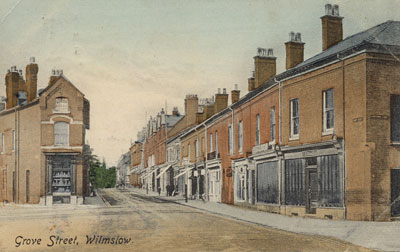
| Wilmslow and Stockport, Cheshire |
| HOME |
| Land Introduction |
| The Worths |
| Connection to All Law Related Pages |
| Wilmslow and Stockport Benjamin Law, his wife, Lydia Sheard Law, and several of their children moved from Batley in Batley Parish, Yorkshire to Hyde, Cheshire (near Stockport) and then Stockport, Cheshire sometime around 1832. Benjamin Law died in Stockport in 1837. Several of his children were married in the area. Some of them appear to have remained near Stockport. Others including Lydia returned to Batley. Benjamin Law was buried in Batley. William, the son of Benjamin and Lydia Law, born in 1809 married Marie (Mary) Worth. Census information indicates that Marie Worth was born in Wilmslow, Cheshire circa 1811. Wilmslow, St. Bartholomew (C of E). An ancient parish, originally comprising the townships of Bollin Fee, Chorley (near Wilmslow), Fulshaw and Pownall Fee. Registers of baptisms 1558-1877, marriages 1558-1887 and burials 1558-1902 are at the CRO. Memorial inscriptions have been published by North Cheshire FHS. "Wilmslow is a village, a parish and a sub-district in Cheshire. The village is on the river Bollin, 6 miles south, south-west of Stockport. The population in 1851 was 4,952." (1) (1) The Imperial Gazetteer of England and Wales, by John Marius Wilson, published in 1870 - 60 years after Marie Worth was born in Wilmslow. |
| Grove Street, Wilmslow, 1904 | 
|
| | |
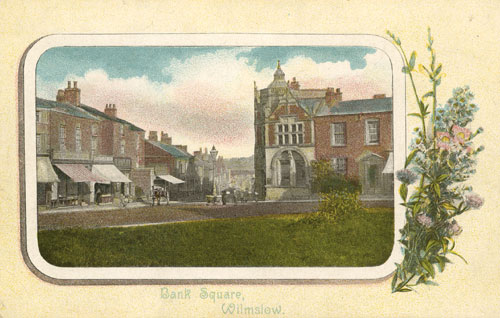 |
|
| Postcard collection of Maggie Land Blanck
Bank Square Wilmslow. No date.
| |
| Church Street, Wilmslow, no date | 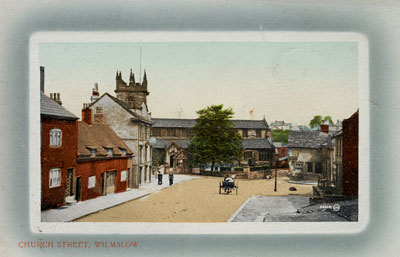
|
| | |
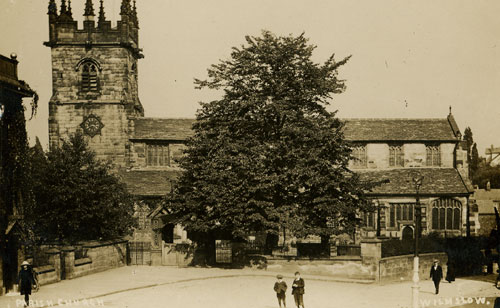 |
|
| Postcard collection of Maggie Land Blanck
St Bartholomew's Church - built between 1517 and 1537. No date. | |
| | |
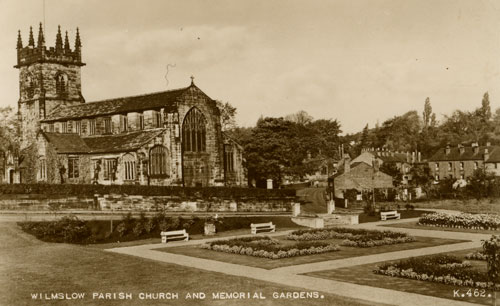 |
|
| Postcard collection of Maggie Land Blanck
St Bartholomew's Church, another view. No date. | |
|
Lindow Common, Wilmslow, 1904 Once the "common" on which local inhabitants grazed their cattle, now a nature reserve. |
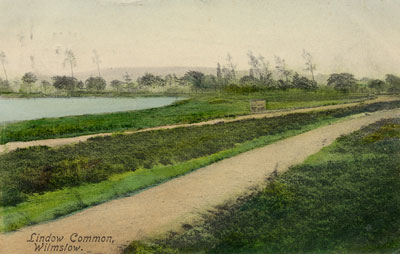
|
| Wilmslow, Hawthorne Hall, no date | 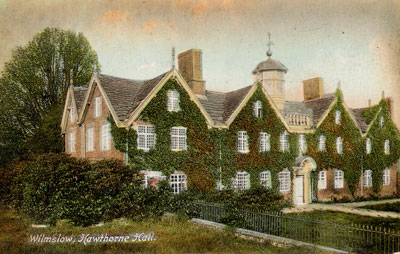
|
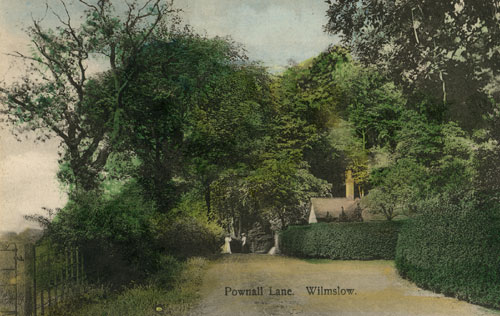
| Pownall Lane Wilmslow |
| | |
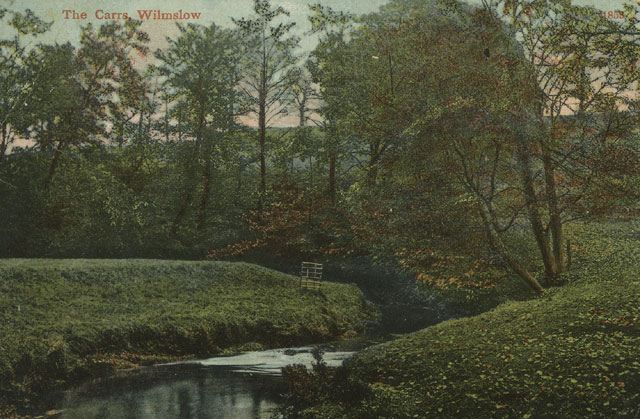 |
|
| Postcard collection of Maggie Land Blanck
The Carrs, Wilmslow Posted 1908 "Carrs, Wilmslow -The River Bollin meanders through picturesque parkland with footpath links into Styal Country Park and the Dean Valley. Ideal for gentle walks, the seventy acres purchased in 1935 by the Wilmslow Urban District Council to mark the jubilee of King George V." Macclesfield Borough Council
| |
| | |
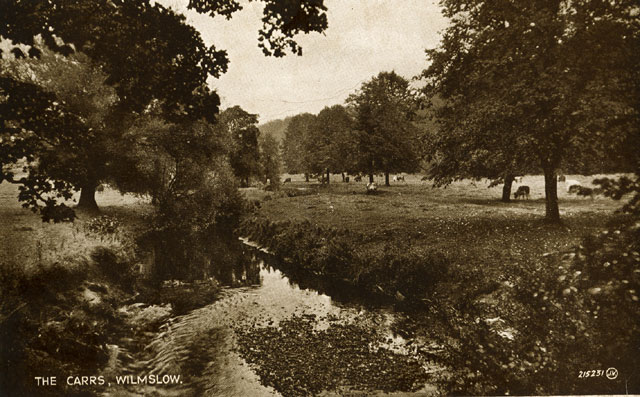 |
|
| Postcard collection of Maggie Land Blanck
The Carrs, Wilmslow. Date unknown | |
| | |
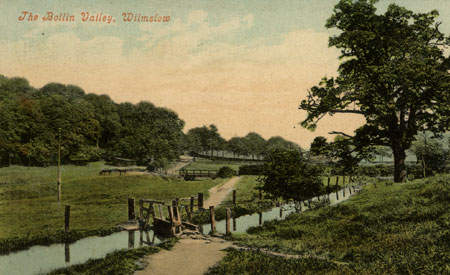 |
|
| Postcard collection of Maggie Land Blanck
The Bollin Valley, Wilmslow. Date unknown | |
| | |
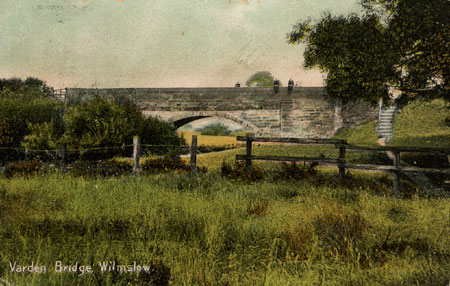 |
|
| Postcard collection of Maggie Land Blanck
Varden Bridge, Wilmslow. Posted 1908 | |
| | |
 |
|
| Postcard collection of Maggie Land Blanck
Wilmslow, Styall Mill. Not posted. Same image listed as 1897. AKA Quarry Bank Mill, founded 1784 by Samuel Greg, was one of the first water powered cotton spinning mills in England and is now a museum. See Quarry Bank Mill. It is one of the least altered factory colonies of the Industrial Revolution and includes the mill, the Styal Estate and Styal village. It is also still a working cotton mill.
The manufacture of cotton cloth was possible in Cheshire because of its damp climate. In areas were the climate was too dry the threads were susceptible to becoming brittle and breaking. The Bollin River provided the water necessary for processing the cotton and powering the mill. The height of cotton manufacturing in northwest England was in the mid 1800s. Most of the raw cotton was imported from the United States. It was transported by canal boats from Liverpool to the mill where it was washed, carded, spun into thread and woven into cloth. The final (and optional) step was printing. Large wooden pint-blocks were used. Printing was the most skilled step in the process. By 1832 Quarry Bank mill was one of the largest cotton spinning mills in England. Cotton weaving was introduced in 1834. Many of the mill workers originally lived in converted farm buildings in Styal. Additional housing was added as the mill grew. As in other industries of the time, child labor was an evil of the cotton mills in Cheshire. Quarry Bank Mill was a noted offender who forced its child labor to work long hours for substandard wages. Child apprentices lived in separate quarters and after the day at the mill were expected to study and tend the Apprentice House garden. | |
| | |
|
Stockport "Stockport is a town, a township, a parish, two sub-districts and a district in Cheshire. The town is on the river Mersey, at the influx of the Tame. It is 5 miles south-south-east of Manchester. Has been occupied by Romans, Saxons, and Normans. It became an important center for the cotton manufacturing trade. The population in 1851 was 90,205." (2) (2) The Imperial Gazetteer of England and Wales, by John Marius Wilson, published in 1870 - 60 years after William Law was born. | |
| | |
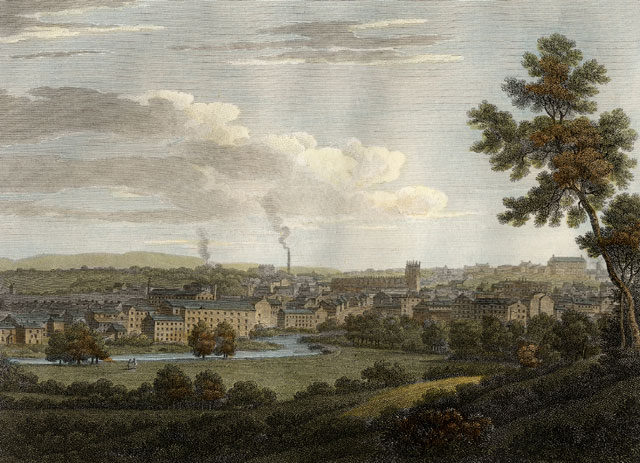 | |
| Print collection of Maggie Land Blanck | |
| Stockport,
J Farington, Published 1810 Benjamin Law and his family moved to Stockport before 1832. He died in Stockport in 1837.
| |
| | |
 | |
| Print collection of Maggie Land Blanck | |
| The Old Bank, Stockport | |
| | |
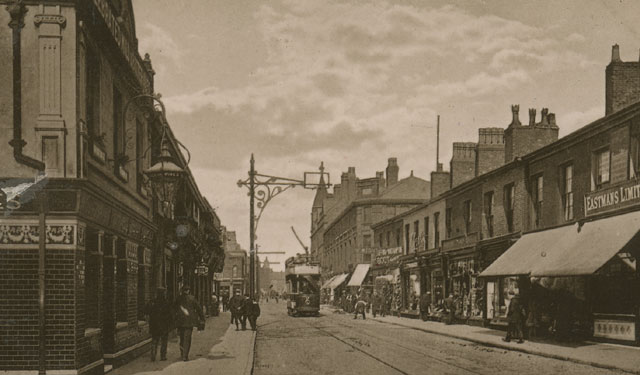 |
|
| Postcard collection of Maggie Land Blanck
Princes Street Stockport. Not posted. | |
| | |
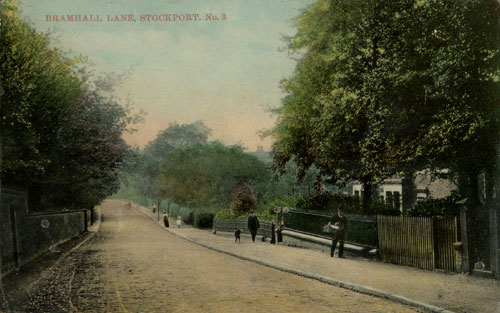 |
|
| Postcard collection of Maggie Land Blanck
Bramhall Lane, Stockport. Posted 1909 | |
| | |
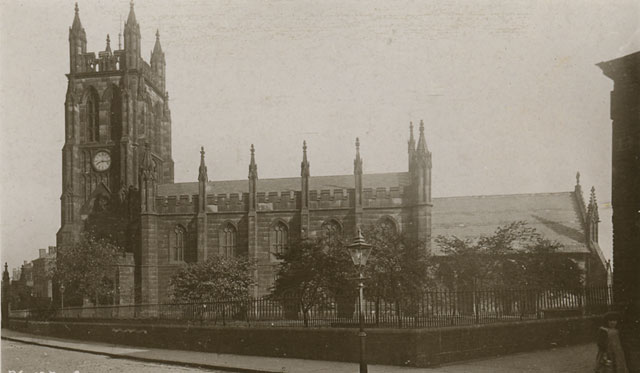 |
|
| Postcard collection of Maggie Land Blanck
Parish Church Posted 1908 | |
| | |
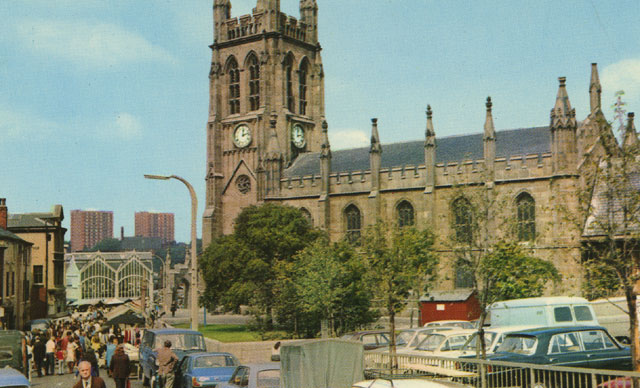 |
|
| Postcard collection of Maggie Land Blanck
Parish Church Not posted | |
| | |
 |
|
| Postcard collection of Maggie Land Blanck
St Mary's Parish Church, Stockport | |
| | |
|
Bollin Fee and Pownal Fee - Wilmslow James Worth born circa 1810 in Wilmslow and Henry Worth born c 1814 in Wilmslow were cotton weavers who lived in Bollin Fee. They may be the brothers of Joseph Worth born circa 1814 in Wilmslow and Mary (Marie) Worth born circa 1811 in Wilmslow. Mary was my ancestor. Bollin Fee is the name of one of Wilmslow's former parishes.
Wilmslow about 7 miles from Manchester was/is situated on the Bollin River was called Le Bolyn in ancient times. Bollinfee was a township in Wilmslow parish. The civil parish was abolished in 1936 and became parts of Alderley Edge and Wilmslow. The population of Bollinfee was 1,506 in 1801. The parish church was St. Bartholomew which served Bollin Fee, Chorley, Fulshaw and Pownall Fee. In Wilmslow in 1850 the there were: St. Bartholomew's parish church, The Wesleyan Methodist in Green Lane, The Friends Meeting House erected in 1831, the Independent Chapel erected in 1846-47 and the Christian Society which met in the old Independent Chapel.. The Gas works were established in 1846 to supply the cotton factory of Wm. Bower and some of the shops and private homes in the village. In 1810 there were said to be no less than 8 large cotton mills in Wilmslow. The principle factory belonged to Samuel Gregg at Styall. Samuel Greg of Quarry Bank Mill employed children ages 9 and older. Legally children as young as 4 years could be employed!!! Greg preferred girls as their fingers were more nimble. In 1790 he build a house to accommodate up to one hundred indentured child laborers. The Apprentices House at Styal was supervised by a couple who had their own apartment. The children worked 14 hours a day beginning at 6:00 in the morning. They got a 10 minute breakfast break of milk and porridge and a half hour lunch break of potatoes and bacon. Cotton lint inflamed the eyes and congested the lungs. The factory was artificially heated to close to 100 degrees to keep the threads from breaking. The noise was deafening. Careless children could lose a finger or two. Runaways were quickly found and punished. The majority of these children came form orphanages. They were indentured until the age of 18 by an employer who agreed to feed cloth and educate the children. In general pay for mill workers was low. Male weavers earned 10 shilling a week. Deductions wer made for faults in the fabric, work stoppages, and lateness. Workers were sometimes paid in token that could only be redeemed in the mill store. In 1831 this system was abolished. The cotton mill was not operating in 1850 when Samuel Bagshaw visited the area. Charles Barber was operating a silk mill on the banks of the bollin river in 1850. A feast day was held on August 28th (St. Augustine). The township of Bollin Fee in included the hamles of Hugh and Dean Row and made up most of the village of Wilmslow. In 1841 there were 383 houses and 2,212 inhabitants. The hamlet of Dean Row consisted of scattered houses east of Wilmslow church. The hamlet of Hough consisted of mostly scattered farm houses. Samuel Greg built the Quarry Bank mill in 1874. There were cotton weaving in Bollin Fee as early as 1797 when on Robert Adrern of Bollin Fee, cotton spinner, was required to pay support of his bastard child. In 1810 Joseph Whitaker, Bollin Fee, cotton weaver, was required to pay child support for his bastard child. In 1810 Henry Haywood of Pqwell Fee indentured himself for 3 years to Timothy Haywood of Manchester to "learn the art and mystery of a weaver." Principally a farming community, in the 18th century Wilmslow moved into manufacturing. By 1787 "Finney" observed "within my memory the village or town of Wilmslow is greatly increased in number of houses, and consequently of inhabitants; but this year, a beginning having been made in building the New Road by the mill though Ladyfield, it is probable, a new street will rise up there in a few years." Finney said the inhabitants of Wilmslow numbered: Hough 247, Deanrow, 135 Powenal Fee 14 for a total of 396.
By 1831 extensive cotton and silk mills lined the Bollin River.
By 1838 it was said that the primary occupation of Bollin Fee was silk and cotton weaving. By 1831 the population was 1,784 an increase of 278 persons from 1801. Another employer in Wilmslow was the copper mines at Alderley Edge and Quarry Bank on the Bollin river. James Worth worked in the copper mines in 1861. Veins of copper, iron and lead were found in the sandstone around Wilmslow. In 1889 it was noted that the population of Wilmslow was healthier than it had been in the past. Smallpox (formerly so common that a considerable number of persons whom one met in the street were pitted by that terrible disease) has so far been eradicated that a face disfigured by the disease is now rarely seen. Medical assistance was not so accessible to the poor as in more recent times; this circumstance, however, signified the less as such aid was less effectual. The interiors of cottages were perhaps quite as clean as we generally find them at the present day, but the accumulations around them were noxious aud offensive. The filth of Wilmslow seethed and fermented as it trickled towards the river in its course down the centre of the ill-kept street. Fevers were almost chronic, aud fierce epidemics swept off their numerous victims. Sanitary science was unknown. Carbolic acid was unheard of, and Scheele had only discovered chlorine in the last quarter of the previous century. Yet the parish of Wilmslow has ever been noted for its comparative salubrity. The fresh air blown across Lindow Common is charged with ozone, the inhabitants are mostly scattered over the parish, and the village itself is so small that the evils arising from what are termed "rookeries'' (which raise the death-rate in towns) could affect at most but a small proportion of the population."\In Wilmslow and Alderley Edge Roy Westall states that "Wilmslow had no township until 1894 when the townships of Bollin Fee, Chorley, Fulshaw and Pownall Fee were combined to create Wilmslow Civil parish." Prior to 1894 Wilmslow "referred only to the area on which stood the parish church". The parish church is situated near the Bollin river. Sources:
| |
| The Worths | |
| Connection to All Law Related Pages | |
| Wilmslow Today To see images and to get information on modern Wilmslow go to The Wilmslow Website | |
| If you have any suggestions, corrections, information, copies of documents, or photos that you would like to share with this page, please contact me at maggie@maggieblanck.com |
| RETURN TO TOP OF PAGE |
| Please feel free to link to this web page. You may use images on this web page provided that you give proper acknowledgement to this web page and include the same acknowledgments that I have made to the provenance of the image. Please be judicious. Please don't use all the images. You may quote my original text from this web page and use any cited quotes on this web page provided you give proper acknowledgement to this web page and include the same acknowledgments that I have made to the provenance of the information. Please do not cut and paste the whole page. You may NOT make use any of the images or information on this web page for your personal profit. You may NOT claim any content of this web page as your original idea. Thanks, Maggie |
| ©Maggie Land Blanck - Page created 2004 - Latest update, November 2015 |
| RETURN TO TOP OF PAGE |